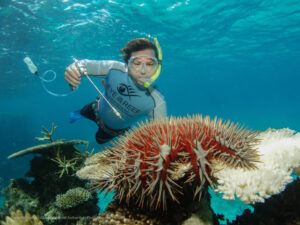The study led by the Reef Authority in collaboration with research and delivery partners demonstrated up to a six-fold reduction in starfish numbers and a 44 per cent increase in coral cover across regions that received timely and sufficient control effort.

While crown-of-thorns starfish are native to the Reef, outbreaks can cause broadscale coral loss and reef degradation, which are another pressure on top of culminative impacts like coral bleaching and cyclones, further impacting on reef health.
Reef Authority Chief Scientist Dr Roger Beeden said this long-term data demonstrated that suppressing outbreaks of the coral-eating starfish has great benefits for the Marine Park.
“This study shows targeted surveillance and culling can effectively suppress crown-of-thorns starfish outbreaks and protect coral across entire reefs and regions, which is vital to the Reef, especially during times of stress,” Dr Beeden said.
“Unlike other major causes of coral mortality, crown-of-thorns starfish outbreaks can be directly managed by targeted manual control — it is an effective, efficient, and scalable management action that is critical for the Great Barrier Reef’s long-term health and resilience.”
“Climate change remains the biggest threat to the Great Barrier Reef and management actions that support the Reef’s resilience are vital,” Dr Beeden said.
The study drew upon data from the Banksia Sustainability Award winning Crown-of-thorns Starfish Control Program and the Australian Institute of Marine Science’s (AIMS) Long-Term Monitoring Program. Among the findings:
- Coral growth and recovery occurred on reefs with crown-of-thorns starfish outbreaks that received timely and sufficient culling effort. Reefs with crown-of-thorns starfish outbreaks that received limited, late, or no culling efforts resulted in coral loss and habitat degradation.
- Crown-of-thorns starfish numbers were up to six-times lower on reefs where outbreaks were effectively suppressed in the most recent outbreak (2010-2022) compared to the previous outbreak (1998-2008).
- Effective suppression of crown-of-thorns starfish outbreaks coincided with increases in live coral cover of up to 44% across entire reef sectors, while the earlier outbreak witnessed significant declines of up to 37%.
- Coral protection benefits occurred across entire regions of the Reef –– and not just at individual reefs –– where culling was conducted, possibly due to suppression of the starfish’s spawning output and a reduced supply of their larvae to downstream reefs.
AIMS’ Long-Term Monitoring Program leader and study co-author Dr Mike Emslie, said combining a comprehensive dataset with information from the Control Program provided a full picture of the Program’s success.
“AIMS has been monitoring crown-of-thorns starfish populations on the Great Barrier Reef for decades as part of its Long-Term Monitoring Program, providing information for Reef managers on starfish outbreaks and their progress along the Reef,” Dr Emslie said.
“Combining this comprehensive dataset with information from the Crown-of-thorns Starfish Control Program allowed us to fully appraise the culling program, and gain these encouraging results,” he added.
Co-author of the study and Great Barrier Reef Foundation Crown-of-thorns Starfish Control Innovation Program Director, Dr Mary Bonin, described the effect the program has had on helping to protect important habitats for marine creatures.
“This landmark study shows that controlling crown-of-thorns starfish outbreaks is an effective action we are taking to directly protect corals at scale. The coral protected through this program continues to support the biodiversity of the Great Barrier Reef, providing habitat for thousands of marine species and helping repopulate damaged areas,” Dr Bonin added.
Reef and Rainforest Research Centre Managing Director, Sheriden Morris, said researchers and Reef managers have worked together over a number of years to establish innovative methods to achieve results.
“This world-first breakthrough in integrated pest management in a marine environment was achieved by bringing together researchers from multiple disciplines to find a novel solution under the National Environmental Science Program,” Ms Morris said.
The full study is published in the Public Library of Science ONE (PLOSONE).








